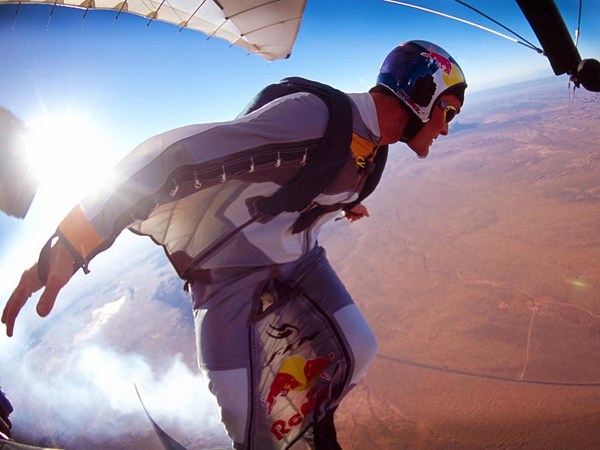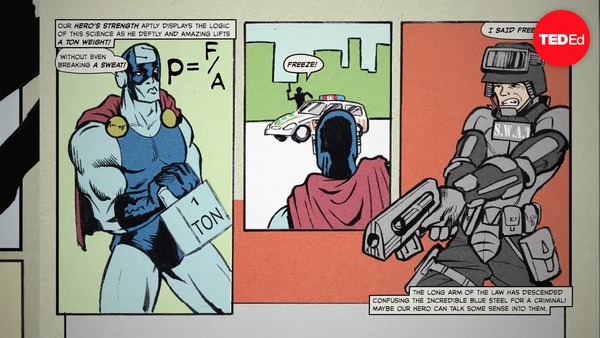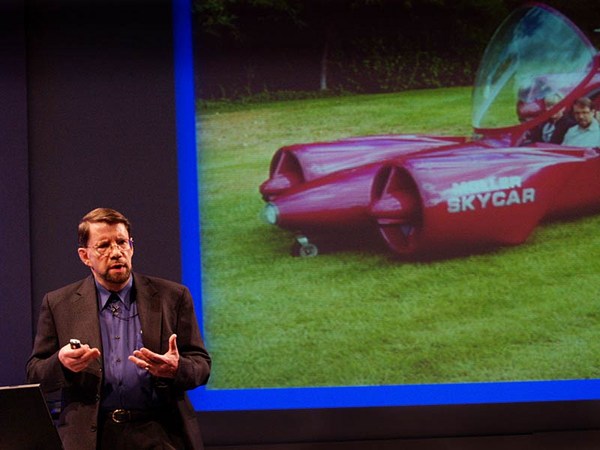I'm extremely excited to be given the opportunity to come and speak to you today about what I consider to be the biggest stunt on Earth. Or perhaps not quite on Earth. A parachute jump from the very edge of space. More about that a bit later on.
What I'd like to do first is take you through a very brief helicopter ride of stunts and the stunts industry in the movies and in television, and show you how technology has started to interface with the physical skills of the stunt performer in a way that makes the stunts bigger and actually makes them safer than they've ever been before.
I've been a professional stunt man for 13 years. I'm a stunt coordinator. And as well as perform stunts I often design them. During that time, health and safety has become everything about my job. It's critical now that when a car crash happens it isn't just the stunt person we make safe, it's the crew. We can't be killing camera men. We can't be killing stunt men. We can't be killing anybody or hurting anybody on set, or any passerby. So, safety is everything. But it wasn't always that way.
In the old days of the silent movies -- Harold Lloyd here, hanging famously from the clock hands -- a lot of these guys did their own stunts. They were quite remarkable. They had no safety, no real technology. What safety they had was very scant. This is the first stunt woman, Rosie Venger, an amazing woman. You can see from the slide, very very strong. She really paved the way at a time when nobody was doing stunts, let alone women.
My favorite and a real hero of mine is Yakima Canutt. Yakima Canutt really formed the stunt fight. He worked with John Wayne and most of those old punch-ups you see in the Westerns. Yakima was either there or he stunt coordinated. This is a screen capture from "Stagecoach," where Yakima Canutt is doing one of the most dangerous stunts I've ever seen. There is no safety, no back support, no pads, no crash mats, no sand pits in the ground. That's one of the most dangerous horse stunts, certainly.
Talking of dangerous stunts and bringing things slightly up to date, some of the most dangerous stunts we do as stunt people are fire stunts. We couldn't do them without technology. These are particularly dangerous because there is no mask on my face. They were done for a photo shoot. One for the Sun newspaper, one for FHM magazine. Highly dangerous, but also you'll notice it doesn't look as though I'm wearing anything underneath the suit. The fire suits of old, the bulky suits, the thick woolen suits, have been replaced with modern materials like Nomex or, more recently, Carbonex -- fantastic materials that enable us as stunt professionals to burn for longer, look more spectacular, and in pure safety. Here's a bit more. There's a guy with a flame thrower there, giving me what for.
One of the things that a stuntman often does, and you'll see it every time in the big movies, is be blown through the air. Well, we used to use trampettes. In the old days, that's all they had. And that's a ramp. Spring off the thing and fly through the air, and hopefully you make it look good.
Now we've got technology. This thing is called an air ram. It's a frightening piece of equipment for the novice stunt performer, because it will break your legs very, very quickly if you land on it wrong. Having said that, it works with compressed nitrogen. And that's in the up position. When you step on it, either by remote control or with the pressure of your foot, it will fire you, depending on the gas pressure, anything from five feet to 30 feet. I could, quite literally, fire myself into the gallery. Which I'm sure you wouldn't want. Not today.
Car stunts are another area where technology and engineering advances have made life easier for us, and safer. We can do bigger car stunts than ever before now. Being run over is never easy. That's an old-fashioned, hard, gritty, physical stunt. But we have padding, and fantastic shock-absorbing things like Sorbothane -- the materials that help us, when we're hit like this, not to hurt ourselves too much.
The picture in the bottom right-hand corner there is of some crash test dummy work that I was doing. Showing how stunts work in different areas, really. And testing breakaway signpost pillars. A company makes a Lattix pillar, which is a network, a lattice-type pillar that collapses when it's hit. The car on the left drove into the steel pillar. And you can't see it from there, but the engine was in the driver's lap. They did it by remote control. I drove the other one at 60 miles an hour, exactly the same speed, and clearly walked away from it.
Rolling a car over is another area where we use technology. We used to have to drive up a ramp, and we still do sometimes. But now we have a compressed nitrogen cannon. You can just see, underneath the car, there is a black rod on the floor by the wheel of the other car. That's the piston that was fired out of the floor. We can flip lorries, coaches, buses, anything over with a nitrogen cannon with enough power. (Laughs)
It's a great job, really. (Laughter) It's such fun! You should hear some of the phone conversations that I have with people on my Bluetooth in the shop. "Well, we can flip the bus over, we can have it burst into flames, and how about someone, you know, big explosion." And people are looking like this ... (Laughs) I sort of forget how bizarre some of those conversations are.
The next thing that I'd like to show you is something that Dunlop asked me to do earlier this year with our Channel Five's "Fifth Gear Show." A loop-the-loop, biggest in the world. Only one person had ever done it before. Now, the stuntman solution to this in the old days would be, "Let's hit this as fast as possible. 60 miles an hour. Let's just go for it. Foot flat to the floor." Well, you'd die if you did that.
We went to Cambridge University, the other university, and spoke to a Doctor of Mechanical Engineering there, a physicist who taught us that it had to be 37 miles an hour. Even then, I caught seven G and lost a bit of consciousness on the way in. That's a long way to fall, if you get it wrong. That was just about right. So again, science helps us, and with the engineering too -- the modifications to the car and the wheel.
High falls, they're old fashioned stunts. What's interesting about high falls is that although we use airbags, and some airbags are quite advanced, they're designed so you don't slip off the side like you used to, if you land a bit wrong. So, they're a much safer proposition. Just basically though, it is a basic piece of equipment. It's a bouncy castle with slats in the side to allow the air to escape. That's all it is, a bouncy castle. That's the only reason we do it. See, it's all fun, this job. What's interesting is we still use cardboard boxes. They used to use cardboard boxes years ago and we still use them. And that's interesting because they are almost retrospective. They're great for catching you, up to certain heights.
And on the other side of the fence, that physical art, the physical performance of the stuntman, has interfaced with the very highest technology in I.T. and in software. Not the cardboard box, but the green screen. This is a shot of "Terminator," the movie. Two stunt guys doing what I consider to be a rather benign stunt. It's 30 feet. It's water. It's very simple. With the green screen we can put any background in the world on it, moving or still, and I can assure you, nowadays you can't see the joint. This is a parachutist with another parachutist doing exactly the same thing. Completely in the safety of a studio, and yet with the green screen we can have some moving image that a skydiver took, and put in the sky moving and the clouds whizzing by.
Decelerator rigs and wires, we use them a lot. We fly people on wires, like this. This guy is not skydiving. He's being flown like a kite, or moved around like a kite.
And this is a Guinness World Record attempt. They asked me to open their 50th anniversary show in 2004. And again, technology meant that I could do the fastest abseil over 100 meters, and stop within a couple of feet of the ground without melting the rope with the friction, because of the alloys I used in the descender device. And that's Centre Point in London. We brought Oxford Street and Tottenham Court Road to a standstill.
Helicopter stunts are always fun, hanging out of them, whatever. And aerial stunts. No aerial stunt would be the same without skydiving. Which brings us quite nicely to why I'm really here today: Project Space Jump.
In 1960, Joseph Kittenger of the United States Air Force did the most spectacular thing. He did a jump from 100,000 feet, 102,000 to be precise, and he did it to test high altitude systems for military pilots in the new range of aircraft that were going up to 80,000 feet or so. And I'd just like to show you a little footage of what he did back then. And just how brave he was in 1960, bear in mind.
Project Excelsior, it was called. There were three jumps. They first dropped some dummies. So that's the balloon, big gas balloon. It's that shape because the helium has to expand. My balloon will expand to 500 times and look like a big pumpkin when it's at the top. These are the dummies being dropped from 100,000 feet, and there is the camera that's strapped to them. You can clearly see the curvature of the Earth at that kind of altitude. And I'm planning to go from 120,000 feet, which is about 22 miles. You're in a near vacuum in that environment, which is in minus 50 degrees. So it's an extremely hostile place to be.
This is Joe Kittenger himself. Bear in mind, ladies and gents, this was 1960. He didn't know if he would live or die. This is an extremely brave man. I spoke with him on the phone a few months ago. He's a very humble and wonderful human being. He sent me an email, saying, "If you get this thing off the ground I wish you all the best." And he signed it, "Happy landings," which I thought was quite lovely. He's in his 80s and he lives in Florida. He's a tremendous guy. This is him in a pressure suit.
Now one of the challenges of going up to altitude is when you get to 30,000 feet -- it's great, isn't it? -- When you get to 30,000 feet you can really only use oxygen. Above 30,000 feet up to nearly 50,000 feet, you need pressure breathing, which is where you're wearing a G suit. This is him in his old rock-and-roll jeans there, pushing him in, those turned up jeans. You need a pressure suit. You need a pressure breathing system with a G suit that squeezes you, that helps you to breathe in and helps you to exhale.
Above 50,000 feet you need a space suit, a pressure suit. Certainly at 100,000 feet no aircraft will fly. Not even a jet engine. It needs to be rocket-powered or one of these things, a great big gas balloon. It took me a while; it took me years to find the right balloon team to build the balloon that would do this job. I've found that team in America now. And it's made of polyethylene, so it's very thin. We will have two balloons for each of my test jumps, and two balloons for the main jump, because they notoriously tear on takeoff. They're just so, so delicate.
This is the step off. He's written on that thing, "The highest step in the world." And what must that feel like? I'm excited and I'm scared, both at the same time in equal measures. And this is the camera that he had on him as he tumbled before his drogue chute opened to stabilize him. A drogue chute is just a smaller chute which helps to keep your face down. You can just see them there, popping open. Those are the drogue chutes. He had three of them. I did quite a lot of research. And you'll see in a second there, he comes back down to the floor.
Now just to give you some perspective of this balloon, the little black dots are people. It's hundreds of feet high. It's enormous. That's in New Mexico. That's the U.S. Air Force Museum. And they've made a dummy of him. That's exactly what it looked like. My gondola will be more simple than that. It's a three sided box, basically.
So I've had to do quite a lot of training. This is Morocco last year in the Atlas mountains, training in preparation for some high altitude jumps. This is what the view is going to be like at 90,000 feet for me. Now you may think this is just a thrill-seeking trip, a pleasure ride, just the world's biggest stunt. Well there's a little bit more to it than that.
Trying to find a space suit to do this has led me to an area of technology that I never really expected when I set about doing this. I contacted a company in the States who make suits for NASA. That's a current suit. This was me last year with their chief engineer. That suit would cost me about a million and a half dollars. And it weighs 300 pounds and you can't skydive in it. So I've been stuck. For the past 15 years I've been trying to find a space suit that would do this job, or someone that will make one.
Something revolutionary happened a little while ago, at the same facility. That's the prototype of the parachute. I've now had them custom make one, the only one of its kind in the world. And that's the only suit of its kind in the world. It was made by a Russian that's designed most of the suits of the past 18 years for the Soviets. He left the company because he saw, as some other people in the space suit industry, an emerging market for space suits for space tourists.
You know if you are in an aircraft at 30,000 feet and the cabin depressurizes, you can have oxygen. If you're at 100,000 feet you die. In six seconds you've lost consciousness. In 10 seconds you're dead. Your blood tries to boil. It's called vaporization. The body swells up. It's awful. And so we expect -- it's not much fun. We expect, and others expect, that perhaps the FAA, the CAA might say, "You need to put someone in a suit that's not inflated, that's connected to the aircraft." Then they're comfortable, they have good vision, like this great big visor. And then if the cabin depressurizes while the aircraft is coming back down, in whatever emergency measures, everyone is okay.
I would like to bring Costa on, if he's here, to show you the only one of its kind in the world. I was going to wear it, but I thought I'd get Costa to do it, my lovely assistant. Thank you. He's very hot. Thank you, Costa. This is the communication headset you'll see on lots of space suits. It's a two-layer suit. NASA suits have got 13 layers. This is a very lightweight suit. It weighs about 15 pounds. It's next to nothing. Especially designed for me.
It's a working prototype. I will use it for all the jumps. Would you just give us a little twirl, please, Costa? Thank you very much. And it doesn't look far different when it's inflated, as you can see from the picture down there.
I've even skydived in it in a wind tunnel, which means that I can practice everything I need to practice, in safety, before I ever jump out of anything. Thanks very much, Costa. (Applause)
Ladies and gentlemen, that's just about it from me. The status of my mission at the moment is it still needs a major sponsor. I'm confident that we'll find one. I think it's a great challenge. And I hope that you will agree with me, it is the greatest stunt on Earth. Thank you very much for your time. (Applause)





